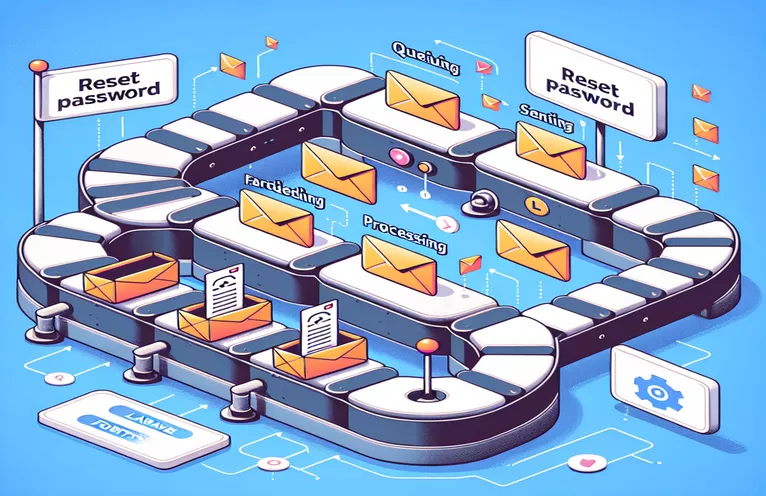A Comprehensive Guide to Email Queue System with Laravel Fortify
Modern online applications need to manage user authentication in an efficient and safe setting. The well-known PHP framework Laravel offers a vast ecosystem to manage many parts of web development, such as password management and user authentication. More sophisticated methods for handling password resets are now available to developers with Laravel 10, especially with the integration of Fortify, an adaptable authentication solution. Putting in place a queue system to send emails for password resets is essential to improving user experience since it guarantees timely correspondence without taxing the server.
Scalability and performance of Laravel apps are greatly enhanced by the ability to queue password reset emails directly from the database. It makes use of the queue system that Laravel comes with, enabling asynchronous email delivery and, consequently, a more responsive application. In order to complete this process, HTML content must be pulled from the database and queued for email delivery. This requires a thorough understanding of Laravel Fortify's features and the underlying queuing processes. The emphasis on database-driven queues for email transmission highlights how flexible Laravel is when it comes to handling queued processes, which is a crucial feature for developers who want to automate email correspondence in their projects.
| Command | Description |
|---|---|
| Fortify::resetPasswordView() | Describes the view that appears after a user asks for a password reset. |
| Fortify::resetPasswordUsing() | Alters the password reset's behavior, including the email queueing procedure. |
| Mail::to()->queue() | Uses the built-in queue mechanism in Laravel to queue an email for delivery to the designated address. |
| php artisan queue:table | Creates the database table migration for the queue jobs. |
| php artisan migrate | Carries out the migrations and creates the jobs table for queueing in the database. |
| php artisan queue:work | Initiates the queue worker's processing of the jobs in the queue. |
A Comprehensive Look at Laravel's Queued Email Mechanism
With a focus on email queuing for asynchronous delivery, the mechanism included in the scripts demonstrates a complex method of managing password resets in Laravel 10 using Fortify. Using Fortify's API to customize the password reset feature is the first step in this approach. The Fortify::resetPasswordUsing() technique is essential since it makes the password reset procedure customizable. In this manner, an email with HTML content (often taken from the database) is dynamically generated by the script, which then queues the email for transmission. Here, it's important to utilize Mail::to()->queue(), which tells Laravel to queue the email using the framework's integrated queue system. Laravel's mailer system makes this easier by supporting queueing right out of the box, which eliminates the need for instant processing and improves the responsiveness and scalability of the application.
Furthermore, this queuing mechanism is enabled in large part by the configuration steps described in the second script. Laravel uses the database table for job queuing when the QUEUE_CONNECTION directive in the .env file is set to database. The foundation that the database needs to support this is created by the commands php artisan queue:table and php artisan migrate. After being configured, php artisan queue:work starts the queue worker, which watches for and completes tasks from the queue, such as sending the emails that are queued. This method streamlines email sending procedures without using the system's immediate resources, especially for tasks like password resets where prompt delivery is essential.
Password Driven by Queue Using Laravel 10 and Fortify, Reset Emails
PHP with Laravel Framework
// In App/Providers/FortifyServiceProvider.phpuse Laravel\Fortify\Fortify;use App\Models\User;use Illuminate\Support\Facades\Mail;use App\Mail\ResetEmail; // Ensure you create this Mailablepublic function boot(){Fortify::resetPasswordView(fn ($request) => view('auth.reset-password', ['request' => $request]));Fortify::resetPasswordUsing(function (User $user, string $token) {// Retrieve your HTML content from the database here$htmlContent = 'Your HTML Content'; // This should be dynamically retrievedMail::to($user->email)->queue(new ResetEmail($user, $token, $htmlContent));});}
Configuring Laravel Queue System
Laravel.env Configuration using PHP
// In your .env fileQUEUE_CONNECTION=database// Ensure you have run the queue table migrationphp artisan queue:tablephp artisan migrate// To run the queue workerphp artisan queue:work// Your queued jobs will be processed by the worker// Ensure your ResetEmail Mailable implements ShouldQueue// In App/Mail/ResetEmail.phpuse Illuminate\Contracts\Queue\ShouldQueue;class ResetEmail extends Mailable implements ShouldQueue{// Mailable content here}
Examining the Email Queue Functionality in Laravel
The strong queue system in Laravel improves the scalability and performance of applications by postponing the execution of operations, such emailing recipients, to a later time. When connecting with Laravel Fortify for user authentication procedures like password resets, this solution is quite helpful. Developers may greatly improve user experience by reducing response times during user interactions by creating a queue for reset password emails. Tasks are pushed onto a queue as job entries in the queue system, where they are subsequently handled asynchronously by queue workers. Because of this approach, the program may function without blocking, responding to user requests even when complex operations are processed in the background.
Persistence for queued jobs is provided by using the database as a queue driver, preventing work from being lost in the event of an application failure. An email is queued into the database when a user requests a password reset, and the queue worker selects the email to be sent depending on its timeliness and priority. Although the user is unaware of this procedure, it guarantees effective email delivery management that doesn't tax the mail server or application. Emails and other queued jobs can be processed on time by configuring Laravel's scheduler to run queue workers continually. Applications with large user volumes, where immediate processing of all actions may result in bottlenecks, benefit greatly from this architecture.
Frequently Asked Questions about Email Queuing in Laravel
- Is it possible to utilize any mail driver with Laravel's queue system?
- Indeed, any mail driver that Laravel supports—including SMTP, Mailgun, Postmark, and others—can be utilized with the queue system.
- In Laravel, how do I select a queue connection?
- QUEUE_CONNECTION is the key that specifies the queue connection in the.env file. Many drivers, including Redis, SQS, and databases, are supported by Laravel.
- What occurs if an email that is queued doesn't send?
- An automatic retry mechanism for unsuccessful jobs is provided by Laravel. A maximum number of trials for a job can also be specified.
- How should queued jobs be processed?
- Using the command `php artisan queue:work}, the queue worker is used to process jobs that are queued. The name of the queue and connection can also be specified.
- Can I order email jobs in the queue by priority?
- Yes, you can use Laravel to set the priority of your jobs by assigning them to different workers and queues.
Concluding the Laravel Queue-Based Email Delivery System
This walkthrough demonstrates how to set up a queue-based system in Laravel 10 with Fortify to handle password reset emails, highlighting the framework's versatility and resilience. Developers can queue emails effectively and ensure that they are processed asynchronously without overloading the server or the application by using the database queue driver. This approach significantly increases the scalability of the program, enabling it to easily handle a large number of requests. Furthermore, combining a system like this with the adaptable authentication and password reset features of Fortify emphasizes how well-suited Laravel is for creating safe, effective online apps. The password reset email's capability to include HTML content from the database further demonstrates Laravel's adaptability by enabling customized and dynamic email content. All things considered, the implementation of a queue-based email delivery system demonstrates the flexibility and effectiveness of Laravel, which makes it a great option for developers aiming to maximize the performance and user experience of their applications.


